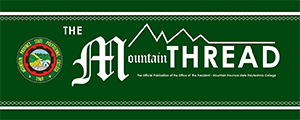DIVERSITY OF NITROGEN FIXING PLANTS IN THE AGROFORESTRY FARMS
IN MOUNTAIN PROVINCE
Alver W. Claudio
ABSTRACT
The study was conducted from February 25 to March 14, 2009 to gather baseline information on the diversity of nitrogen-fixing- plant (NFP) species in selected agroforestry farms in Mountain Province. Specifically, the study looked into the different nitrogen-fixing-plants in selected agroforestry farms, diversity and NFP distribution (altitude), ecological niche of Nitrogen-fixing-plants, taxonomy and the economic importance of Nitrogen-fixing-plants in Mountain Province. There are two sites in the study: site 1 is at Eastern Mountain and site 2 is at Western Mountain Province. Representative agroforestry farms from each site were sampled by establishing a random quadrant measuring 3 x 5 meters. All NFPs and non-NFPs were recorded except for the weeds. Farm coordinates, altitude and slope of the farm were determined with the use of a GPS and a haga meter. One kilogram soil sample was taken in each farm for laboratory analysis. A personal interview with the farm owners was conducted to determine the economic importance and other uses of the identified nitrogen-fixing-plants in their farms.
The Simpson’s Index of Diversity 1-D was used in determining the diversity of nitrogen-fixing-plans in the agroforestry farm.
There are ten (10) nitrogen-fixing-plants found in the agroforestry farms, nine (9) belong to the legume family and 1 Betulaceae.
The altitude and slope of the farm ranges from 140 to 2,265 m ASL and 0- 33% respectively. Agrisilvicultural farms located at North 170 04.575’ longitude, East 1210 27.801’ latitude and North 1680 51.496’ longitude, East 1200 51.731’ latitude records the lowest and highest elevation while agrisilvipastoral farm located at North 170 00.636’ longitude East 1200 52. 605’ latitude and aqua-agrisilvicultural farm located at North 170 10. 208’ longitude, East 1210 21.777 latitude records the lowest and highest slope. In terms of farm size, most of the farms in Eastern Mountain Province have wide land areas with agrisilvipastoral and aqua-agrisilviculture farms each having 4 hectares. Secondary data on plant description, rainfall requirement and cultivation were used in describing the NFPs ecological niche.
Regarding the use of the NFPs, produced from yardlong/snap beans, garden/pigeon pea and peanut are usually sold in the market and what is left is for home consumption. NFPs are used either as farm fence/post/hedgerows, farm tool handle, medicine, fodder, as shade tree or brewed like coffee.
Based from the gathered data, the agroforestry farms in Mountain Province have low diversity.
To increase NFP diversity in the agroforestry farm, the farmers should be encouraged to plant different species of nitrogen-fixing–trees along the farm perimeter as fence/hedges, fodder or within the farm as shade tree for the crops or animals. Intercropping of nitrogen-fixing plants within the farm is necessary. A collaborative effort is needed in encouraging farmers to diversify their farming by using more NFPs in their farms.

















